An Experiment on a Bird in the Air Pump (1768).
As promised, one of my favourite chiaroscurists. The impression Joseph Wright’s work made on me at the age of 13 was one of many revelations from my first visit to the Tate Gallery. The paintings which struck me most of the older works there were all of the Romantic or late-Romantic era: Turner, Francis Danby, John Martin, Philippe de Loutherbourg and Joseph Wright’s enormous An Experiment on a Bird in the Air Pump, which is now housed in the National Gallery. The National Gallery site has this to say about the picture:
A travelling scientist is shown demonstrating the formation of a vacuum by withdrawing air from a flask containing a white cockatoo, though common birds like sparrows would normally have been used. Air pumps were developed in the 17th century and were relatively familiar by Wright’s day. The artist’s subject is not scientific invention, but a human drama in a night-time setting.
The bird will die if the demonstrator continues to deprive it of oxygen, and Wright leaves us in doubt as to whether or not the cockatoo will be reprieved. The painting reveals a wide range of individual reactions, from the frightened children, through the reflective philosopher, the excited interest of the youth on the left, to the indifferent young lovers concerned only with each other.
The figures are dramatically lit by a single candle, while in the window the moon appears. On the table in front of the candle is a glass containing a skull.
As with many paintings, the online reproductions do little justice to the subtlety of Wright’s rendering of light and shade. This remains his most famous picture although he made another on a similar theme, A Philosopher Giving a Lecture on the Orrery (below) and, like Godfried Schalcken, he has at least two studies of people viewing statues by candlelight, a common practice at that time for the way the light gave classical sculpture a spurious life. Wright’s painting of The Alchymist is another popular work, turning up frequently in occult encyclopedias. Being a native of Derby he also became (along with de Loutherbourg) one of the first painters to depict the beginnings of the Industrial Revolution whose flaring furnaces provided an ideal subject for dramatists of flame and shadow.
Before leaving the tenebral world, I’ll note that Claire left a message to say that issue 24 of Cabinet Magazine has a feature on shadows in art, symbolism and philosophy.
The Alchymist, In Search of the Philosopher’s Stone, Discovers Phosphorus, and prays for the successful Conclusion of his operation, as was the custom of the Ancient Chymical Astrologers (1771).
A Philosopher Giving a Lecture on the Orrery (1766).
Academy by Lamplight (1768-69).
Three Persons Viewing the Gladiator by Candlelight (1765).
Previously on { feuilleton }
• Chiaroscuro
• Shadows at Compton Verney
• Death from above
• The apocalyptic art of Francis Danby

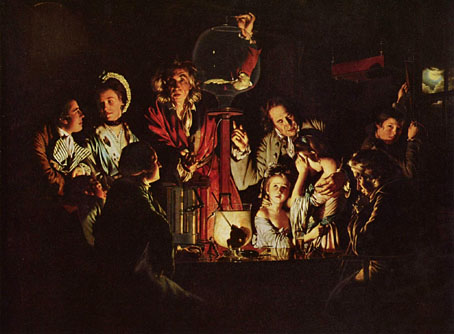
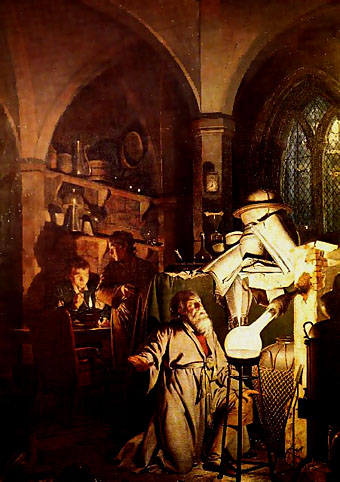
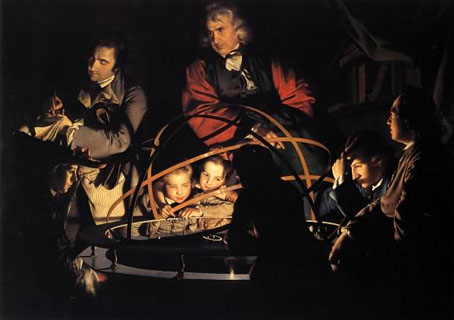
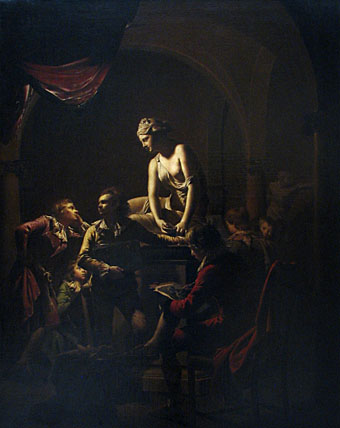
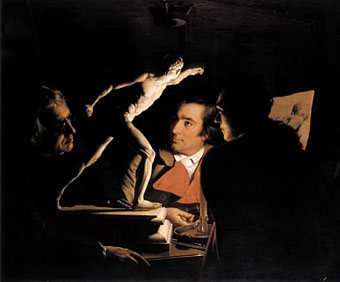
Viewing this on a computer screen doesn’t really do these paintings justice, but what’s new…
I was actually in the National Gallery yesterday for the first time in my life.
The painting that impressed me the most was
http://www.artchive.com/artchive/S/seurat/asnieres.jpg.html
although that was more for its size and colour than anything else.
Amazing that you can get to see so many famous paintings for free.
Especially considering they charge you 20 p to go to the toilet in London. Public toilets are free in Sydney, Australia.
I was in the National last time I was in London as well, and had another gaze at Wright’s masterpiece. Too many great pictures to pick a favourite though.
As for the deficiencies of monitors, all the more reason to visit a gallery!